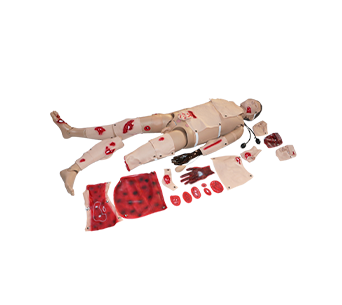■ This simulator is widely used in various departments such as military, fire, police, aviation, coal mines, construction, etc., fire, mountains, high altitude, oil pipes industry, tunnels, collapsed buildings, ruins, explosions and other emergency scenes
■ The joints of the simulator are very flexible, the head can be rotated 180 degrees horizontally, and various poses can be simulated in the emergency scene
■ The surface of the simulator has obvious signs, including sternal notch, sternum, ribs, etc., which is convenient for operation and positioning
■ Each trauma component can be flexibly fixed on the "wounded" body, and can create a real bleeding environment, and the blood flow can be adjusted
■ Pupil teaching: normal pupil on one side, dilated pupil on the other side
■ Nasogastric feeding: the simulated gastric juice can be drawn out if the operation is correct
■ Can check carotid pulse
■ The chest is elastic, and the lung ventilation can be ups and downs
■ You can practice CPR mouth-to-mouth artificial respiration: pinch the nose of the simulator with the thumb and index finger of one hand, lift the jaw with the other hand, tilt the head back, and blow with the lips around the mouth, each time for more than 1 second. Pay attention to the rise and fall of the chest. Cardiac compression: The compression site is the middle of the sternum of the two fingers on the substernal notch of the chest or the level of the nipple connecting the middle of the chest, and the compression frequency is more than 100 times/minute
■ Intramuscular injection: vastus lateralis muscle, upper arm intramuscular injection
■ Can practice common techniques in emergency scene such as hemostasis, cleaning, disinfection, dressing, fixation and handling. Trauma components include:
* Forehead laceration (one bleeding wound)
* Jaw injury (one bleeding wound)
* Chest sucking wound (one bleeding wound)
* Abdominal trauma with small bowel herniation (one bleeding wound)
* Gunshot wound to the palm (one bleeding wound)
* Compound fractures: open fractures of the humerus and forearm (one bleeding wound)
* Compound fractures: open fractures of tibia and calf (one bleeding wound)
* Amputation of the right leg (two bleeding wounds)
* Shock face (a)
* Ⅰ, Ⅱ, Ⅲ degree facial burns (one)
* Modules of lacerations and open fractures of different degrees (twenty-four)"









